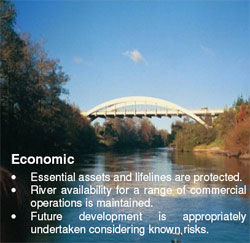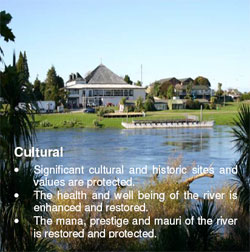| ID |
Actions |
How we will do it |
Who will lead? |
Priority |
Indicative cost(2007) |
| 1. |
Finalise the River Stability Management Strategy |
Consult with key partners to finalise the strategy. |
EW |
H |
|
| 2. |
Facilitate a coordinated approach between councils, communities, tangata whenua and key stakeholders to managing the hazards caused by river instability hazard. |
Establish a River Stability Management Working Group with representatives from key stakeholder groups that meets regularly to discuss management of bed degradation.
Establish a Central Waikato River Mana Whenua Group to discuss possible collaboration on future bed degradation and bank instability management decisions.
Educate riverside property owners on the erosion effects of removing trees and provide information on native and/or best stabilising plant species.
Continue to implement planting programmes in conjunction with the community and encourage the replacement of willows with native bank stabilising plant species progressively over time.
|
EW
EW
EW/TAs
EW/TAs
|
O
O
H
|
5-10% 1 FTE staff member's time for duration of project.
|
| 3. |
Develop an approach to manage riverbank sections identified as being most at future risk. |
Prepare a map of the reach to identify areas in hich physical protection works will be undertaken as a first approach and areas where the river and banks will be allowed to take its own course.
Update the riverbank slope hazard map and priority riverbank areas for revised risk when new information comes to light.
|
EW/TAs
EW
|
O
O
|
$5k
$20k every 5 years
|
| 4. |
Funding policy review |
Undertake a funding policy review of Project Watershed contributor/beneficiary to determine an equitable basis for funding future works. |
EW |
H |
$25k |
| 5. |
Maintain amenity of the river environment. |
Develop a range and select structural options for river stability management to minimise effects on public access, natural character, and amenity values and ensure consistency in appearance. Ensure an assessment is undertaken to determine and minimise the consequential effects of introducing structures. |
EW/TAs |
H |
$20k to develop range of options.
Cost of engineered options selected.
|
| 6. |
Effectively manage development within hazard areas. |
Investigate and where appropriate implement mechanisms including, but not limited to, district/city/regional plan changes e.g. identify hazard zones and establish building setbacks, codes or practice and development design criteria to address issues associated with development and land use within confirmed hazard areas, and detailed subsurface assessments as part of resource consents. |
TAs |
H |
15-20% FTE staff member time for 2 years. |
| 7. |
Monitor river for actual bed degradation effects over time. |
Establish monitoring programme and baseline for river cross sections to determine ongoing bed degradation and identify any critical data gaps.
Consult with, and document information from landowners in high-risk areas to get an idea of the rate of erosion and/or other effects.
Allow yearly contingency to resurvey the riverbed cross sections after a 10-year flood event.
Complete systematic photographic records on regular time intervals from river reconnaissance.
Continually update bed degradation data to reflect riverbed cross section monitoring.
Undertake bed load and sediment sampling to determine the rate of degradation.
|
EW/MRP |
H
M
O
O
O
O
|
$10k
|
| 8. |
Monitor the effects of bed degradation on the Turangawaewae Marae. |
Set up appropriate monitoring programme of riverbank areas adjacent to Turangawaewae Marae. |
EW/tangata
whenua |
M |
|
| 9. |
Identify all significant cultural/heritage sites adjacent to the river that may be at risk. |
Collate existing knowledge of the Central Waikato River to identify sites of significance and map these against areas ubject to present or future high risk from the effects of river instability. |
EW/tangata
whenua |
M |
|
| 10. |
Identify accessibility (walkway and cycle routes issues) |
Investigate what walkways are needed adjacent to the River n the long term which are at risk from present and future bank instability.
Consider existing and strategic requirements for walkway routes in district plans taking into account areas of identified bank stability risk.
Investigate vegetation/engineering options to stabilise banks where inland diversion of walkways is not possible.
|
TAs |
M |
$40-50k.
20% of 1 FTE staff member's time for 2 years.
$5-10k per site.
|
| 11. |
Ensure appropriate construction of access structures to the river (eg boat ramps, jetties) in areas of present and future high bank instability risk. |
Add to Proposed Waikato Regional Plan assessment criteria the consideration of identified present or future high bank instability risk, requiring information on appropriateness of the structure in that area. |
EW |
M |
|
| 12. |
Identify important recreational sites subject to potential future river instability hazards. |
Identify important recreational sites at risk, now and in the future. |
TAs |
H |
15% 1 FTE staff member time for 6 months |
| 13. |
Identify lifelines utilities at threat from the effects of bank instability and bed degradation. |
Condition/risk assessments of infrastructure based on priority ranking of river sections.
Review the recorded drawings for water intake structures to assess the impact of falling water levels. If necessary, relocate water intake structures into deeper water.
|
TAs with
Waikato
Lifelines
Group |
H |
$30-50k |
| 14. |
Protection works:
Recreational Sites
High Value Developments
Stormwater Outfalls
Significant Cultural Sites
Important Lifelines
Upgrade landings & boat ramps
Areas of significant vegetation
|
Consider and implement options for the protection of important recreational sites to maintain access and implement.
Confirm all high value developments and when non-structural options are shown to be ineffective at minimising effects of bed degradation bank instability consider structural options where development is at risk, or integrate with existing structural protection works in the area.
Place new or extended toe erosion protection around stormwater outfalls to mitigate against effects of falling river levels. Investigate alternative methods for protection or alternatively, lower or extend the outfall structure.
Investigate, in conjunction with mana whenua, the use of options that will provide protection to areas of significant cultural and heritage value from erosion, without detracting from these values.
Confirm important lifelines. Assess appropriate options for the protection of lifeline utilities. Develop options to protect, modify or move important lifeline utilities.
Extend landings into deeper water by adding an extra flight of steps, or consider alternatives to provide sufficient water depth.
Extend boat ramps into deeper water as required, or reconstruct boat ramp at lower level.
Identify areas of significant vegetation adjacent to the river and monitor these areas for effects from bank erosion. Implement protection to areas that may be at risk from erosion.
|
TAs
EW/TAs tangata whenua
TAs and
commercial
operators
EW/TA’s
|
M |
Dependent on extent of protection required and design.
Will depend on
impact and infrastructure at risk.
$5k per investigation. Engineering costs
vary depending on option chosen.
Depends on option selected. $5-10k per site investigation.
Will depend upon
extent of impact and type of infrastructure.
5% 1 FTE staff
member time for
duration of project.
|
| 15. |
Focus remediation measures after flood events in areas of high priority. |
Focus remediation efforts following floods to areas where public safety, lifelines, key infrastructure or community/cultural sites of significance are at risk. |
EW/TAs
|
O |
- |
| 16. |
Remove trees that are causing
instability of riverbanks. |
Identify trees that are causing instability (on both private and public land) and in river sections where public health and safety and/or lifelines are affected and consider replacing with appropriate plant species to aid in stabilisation of banks. |
TAs |
M |
$10-20k per TA |
| 17. |
Investigate native and/or best plant species that can survive fluctuating river levels whilst providing bank stabilisation. |
Commission an ecological report to identify bank stabilising native plant species that are suitable for the Waikato River environment.
Link to work previously done by LandCare Trust on appropriate stabilising native species.
|
EW |
H |
- |
| 18. |
Confirm that the 15 River bridges are managed to reduce
or avoid the effects of bed degradation. |
Transit, rail and TAs to ensure that bridge condition assessments are current or underway with necessary management actions. |
TAs/Transit |
H |
- |
| 19. |
Refine knowledge available on
the management of bed
degradation by directly topping
or limiting bed degradation. |
Undertake further research on the effects of ramping of Karapiro outflows on bed degradation.
Further research on the feasibility and acceptability of weirs.
|
MRP
EW
|
M |
$20k
$20-30k
|
| 20. |
Visually monitor the river and tributaries following all flood events to assess changing levels of bed degradation hazard. |
Visually assess the river and main tributaries in urban areas following any flood events for impact on hazard levels.
Maintain a systematic photographic record.
Reassess and update priority areas/actions following flood events.
|
EW |
O |
|








To ask for help or report a problem, contact us
Tell us how we can improve the information on this page. (optional)